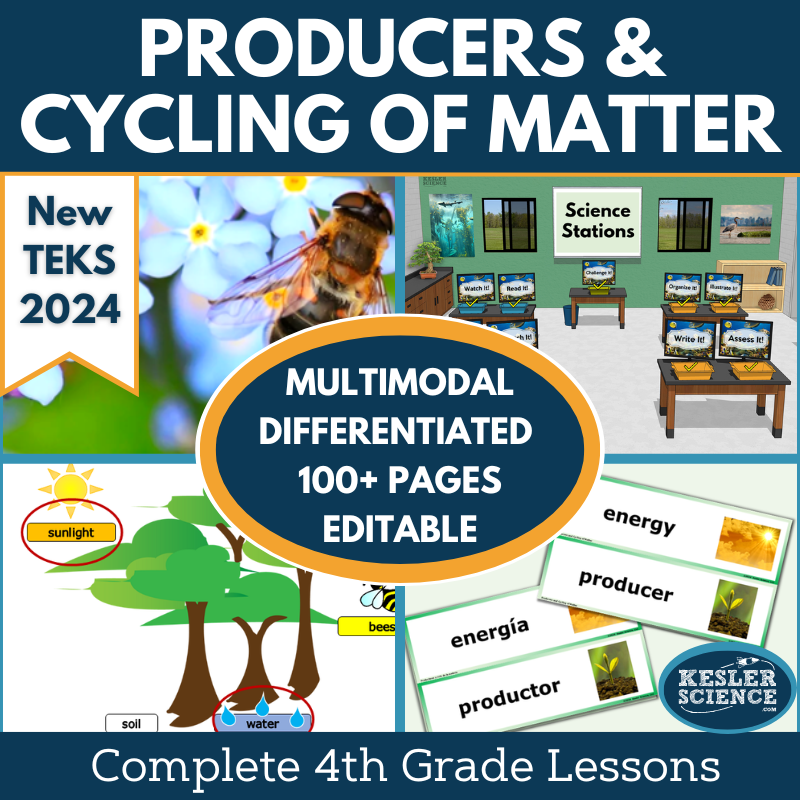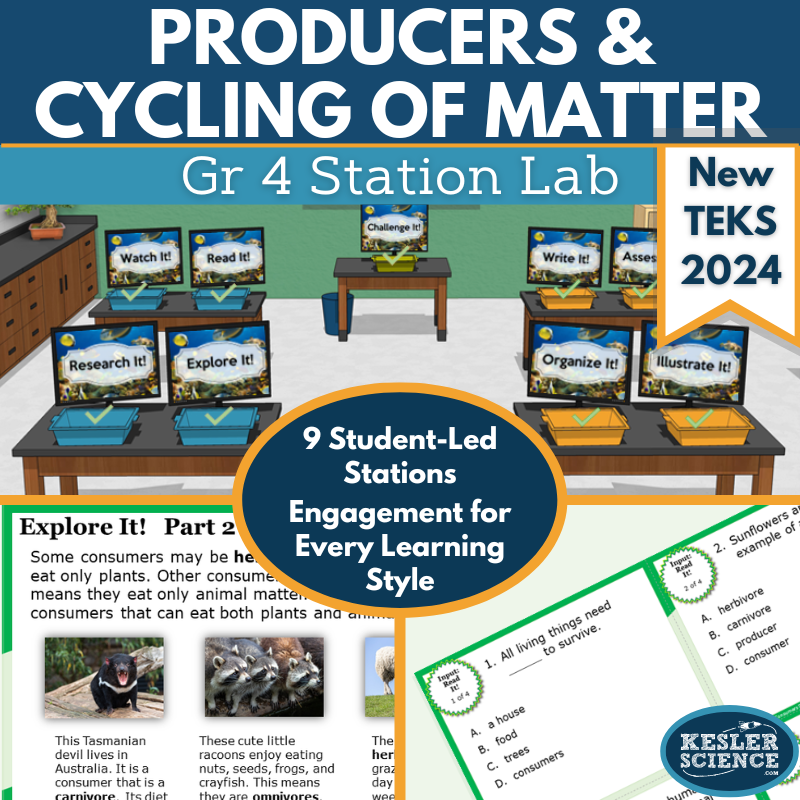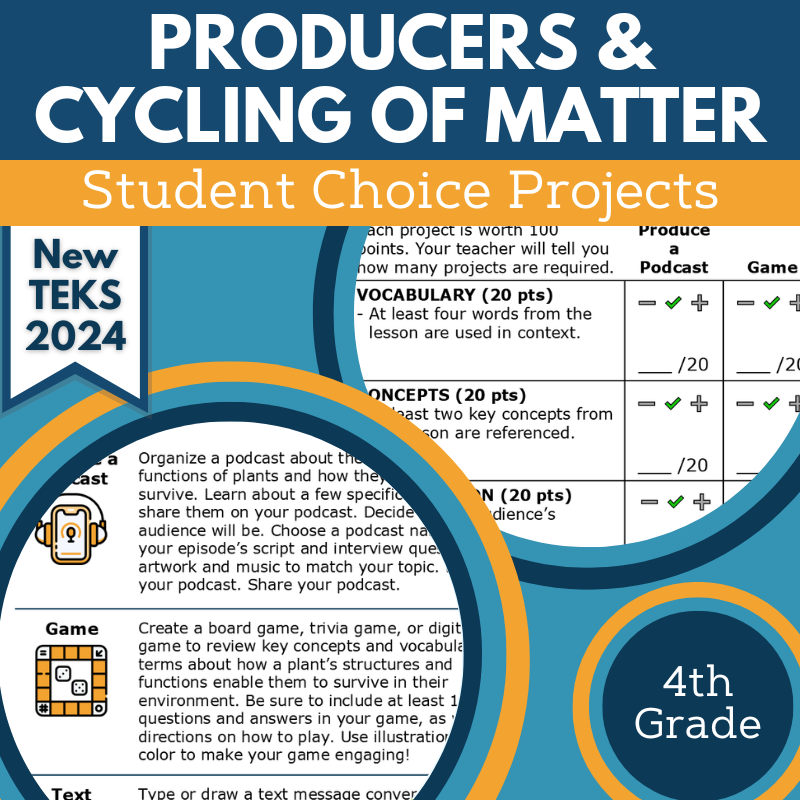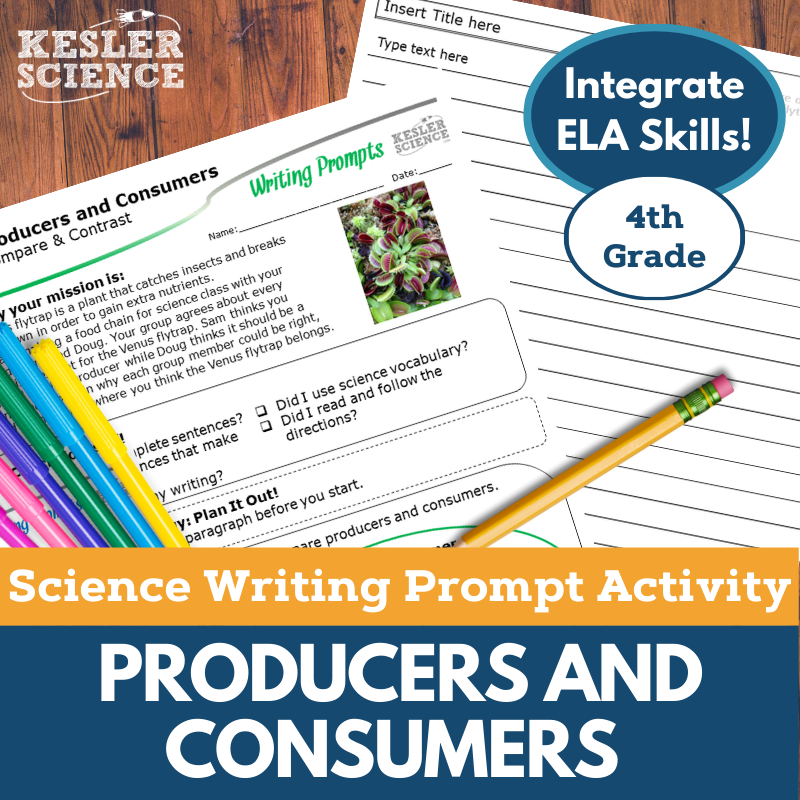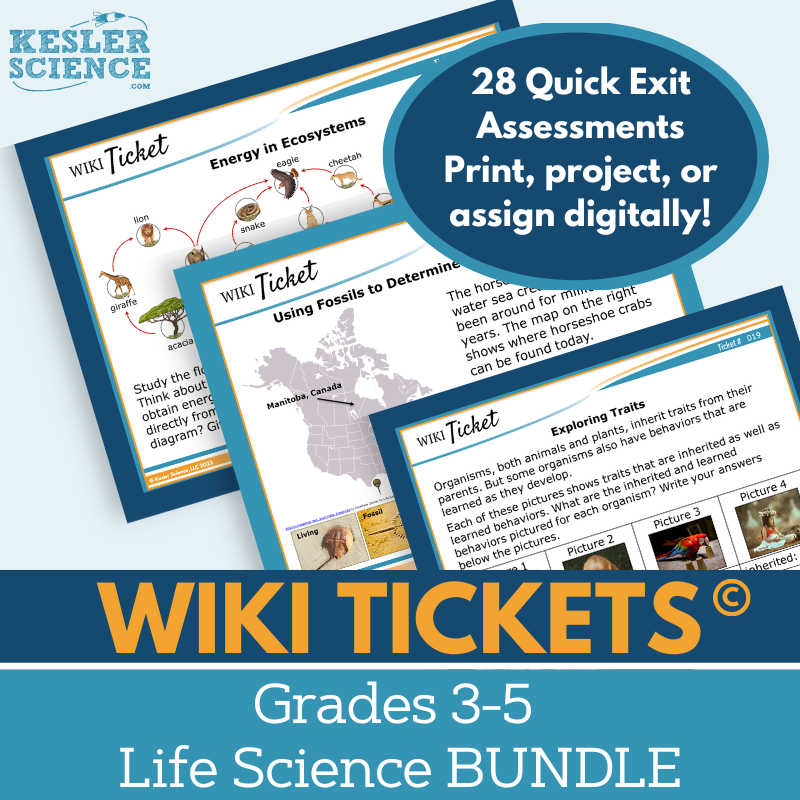Producers & Cycling of Matter Activities for 4th Grade Science
This 4th-grade ecosystems lesson, aligned with TEKS standard 4.12A, helps students explore how producers create their own food using sunlight, water, and carbon dioxide through the cycling of matter. Following the 5E Model, it features hands-on labs, interactive presentations, reading passages in English and Spanish, and creative activities like drawing and organizing information. With editable materials, differentiated support, and STAAR 2.0-aligned assessments, this low-prep, flexible resource is perfect for both in-person and virtual learning. The resources below will give students a comprehensive understanding of producers and the cycling of matter. All of the following materials are also included in the Kesler Science Membership.
The Kesler Science Producers & Cycling of Matter 5E Lesson is a comprehensive, low-prep unit for teaching 4th graders how most producers create their own food using sunlight, water, and carbon dioxide through the cycling of matter. Designed for differentiated, student-led learning, it features editable presentations, worksheets, choice projects, and assessments aligned with the 2021 TEKS 4.12A standard.
The lesson follows the 5E Model with engaging activities, including vocabulary cards in English and Spanish, class discussions, and hands-on experiments. A nine-station lab offers diverse learning experiences—reading passages, videos, research tasks, and creative activities like drawing and writing. Students demonstrate understanding of producers, consumers, and energy flow in ecosystems.
Editable PowerPoints, interactive notebook templates (in English and Spanish), and note-taking guides support explanation. Student-choice projects deepen learning, while STAAR 2.0-aligned assessments and review questions help evaluate mastery. Designed for flexibility, the materials work equally well for in-person or virtual learning environments.
The Kesler Science Producers & Cycling of Matter 5E Lesson is a comprehensive, low-prep unit for teaching 4th graders how most producers create their own food using sunlight, water, and carbon dioxide through the cycling of matter. Designed for differentiated, student-led learning, it features editable presentations, worksheets, choice projects, and assessments aligned with the 2021 TEKS 4.12A standard.
The lesson follows the 5E Model with engaging activities, including vocabulary cards in English and Spanish, class discussions, and hands-on experiments. A nine-station lab offers diverse learning experiences—reading passages, videos, research tasks, and creative activities like drawing and writing. Students demonstrate understanding of producers, consumers, and energy flow in ecosystems.
Editable PowerPoints, interactive notebook templates (in English and Spanish), and note-taking guides support explanation. Student-choice projects deepen learning, while STAAR 2.0-aligned assessments and review questions help evaluate mastery. Designed for flexibility, the materials work equally well for in-person or virtual learning environments.
Engage your 4th-grade class with this student-led station lab aligned with the 2021 TEKS 4.12A standard. Focused on the roles of producers, consumers, and decomposers in the cycling of matter through a food chain, this life science lesson encourages active learning and critical thinking.
Students explore how producers use the Sun’s energy to create food and support ecosystems. The lab features nine differentiated stations designed for independent or small group work, with all necessary signage, literature, resources, and task cards provided. Some stations may require basic materials commonly found in science labs.
The stations offer varied learning experiences: students engage with concepts through activities, videos, readings (available in English and Spanish), and research. They demonstrate their understanding by organizing information, illustrating diagrams of matter cycling through food chains, writing responses, and completing assessments. A bonus challenge station offers extension activities like crosswords, games, and mini-projects for early finishers and advanced learners.
This versatile resource supports both in-class and virtual learning, promoting personalized, student-centered engagement with minimal prep required.
Engage your 4th-grade class with this student-led station lab aligned with the 2021 TEKS 4.12A standard. Focused on the roles of producers, consumers, and decomposers in the cycling of matter through a food chain, this life science lesson encourages active learning and critical thinking.
Students explore how producers use the Sun’s energy to create food and support ecosystems. The lab features nine differentiated stations designed for independent or small group work, with all necessary signage, literature, resources, and task cards provided. Some stations may require basic materials commonly found in science labs.
The stations offer varied learning experiences: students engage with concepts through activities, videos, readings (available in English and Spanish), and research. They demonstrate their understanding by organizing information, illustrating diagrams of matter cycling through food chains, writing responses, and completing assessments. A bonus challenge station offers extension activities like crosswords, games, and mini-projects for early finishers and advanced learners.
This versatile resource supports both in-class and virtual learning, promoting personalized, student-centered engagement with minimal prep required.
The Matter Cycling Student Choice Projects align with the 2021 TEKS standard 4.12A, giving 4th graders the opportunity to choose a project that suits their preferred output style. A project page outlines six student-led options, along with a “design your own” project, and includes an editable rubric for teacher, peer, or self-assessment. This resource is also part of the Producers & Cycling of Matter Complete Lesson for TEKS 4.12A.
These flexible, multimodal projects offer creative ways for students to demonstrate their understanding. Two versions of the project page support differentiation, with modified options for students needing remediation and challenge opportunities for advanced learners. Teachers can adjust the rubric to fit grading preferences.
The resource includes nine project options plus a “design your own” choice, a teacher directions page for support, and editable rubrics that assess vocabulary, concepts, presentation, clarity, and accuracy. Projects use standard classroom supplies like paper, markers, and scissors, with many options available for digital completion.
The Matter Cycling Student Choice Projects align with the 2021 TEKS standard 4.12A, giving 4th graders the opportunity to choose a project that suits their preferred output style. A project page outlines six student-led options, along with a “design your own” project, and includes an editable rubric for teacher, peer, or self-assessment. This resource is also part of the Producers & Cycling of Matter Complete Lesson for TEKS 4.12A.
These flexible, multimodal projects offer creative ways for students to demonstrate their understanding. Two versions of the project page support differentiation, with modified options for students needing remediation and challenge opportunities for advanced learners. Teachers can adjust the rubric to fit grading preferences.
The resource includes nine project options plus a “design your own” choice, a teacher directions page for support, and editable rubrics that assess vocabulary, concepts, presentation, clarity, and accuracy. Projects use standard classroom supplies like paper, markers, and scissors, with many options available for digital completion.
The Producers and Consumers Science and ELA Integrated Writing Activity engages 4th grade students in a creative compare-and-contrast exercise to explore the differences between producers and consumers. This TEKS- and NGSS-aligned resource supports science reasoning and enriched writing, with flexibility for virtual learning and use by 5th graders as well.
Focusing on Renewable and Nonrenewable Resources, the activity includes teacher directions with an answer guide and rubrics, projection and print-friendly handouts, and a digital interactive version compatible with PowerPoint and Google Slides. It works well for cross-curricular learning, pre-test assessments, student choice projects, extra credit, and differentiation.
Perfect for both in-person and remote settings, this low-prep, student-centered activity is ideal for review and assumes students have prior knowledge of the topic or access to research materials.
The Producers and Consumers Science and ELA Integrated Writing Activity engages 4th grade students in a creative compare-and-contrast exercise to explore the differences between producers and consumers. This TEKS- and NGSS-aligned resource supports science reasoning and enriched writing, with flexibility for virtual learning and use by 5th graders as well.
Focusing on Renewable and Nonrenewable Resources, the activity includes teacher directions with an answer guide and rubrics, projection and print-friendly handouts, and a digital interactive version compatible with PowerPoint and Google Slides. It works well for cross-curricular learning, pre-test assessments, student choice projects, extra credit, and differentiation.
Perfect for both in-person and remote settings, this low-prep, student-centered activity is ideal for review and assumes students have prior knowledge of the topic or access to research materials.
The WIKI Tickets© formative assessments offer an engaging way to check student understanding in 3rd–5th grade science. This Life Science Set includes 28 assessments, each available in five formats: a full-screen projection version, three printable handout sizes, and an interactive digital version compatible with PowerPoint and Google Slides.
Aligned with NGSS and TEKS standards for upper elementary science, every standard is covered by at least one ticket, with some topics offering multiple options. A bonus table of contents file highlights the standards alignment.
These versatile assessments can be used in both in-person and virtual settings. Topics covered include animal groups for survival, changes in ecosystems, energy flow in food webs, inherited traits, internal and external structures, fossil evidence, and plant growth, among others.
WIKI stands for "What I Know Is." These colorful, flexible assessments can be used as exit tickets, bellringers, or quick checks for understanding. They can be projected, printed, or assigned digitally through PowerPoint or Google Slides, making them adaptable for any classroom environment.
The WIKI Tickets© formative assessments offer an engaging way to check student understanding in 3rd–5th grade science. This Life Science Set includes 28 assessments, each available in five formats: a full-screen projection version, three printable handout sizes, and an interactive digital version compatible with PowerPoint and Google Slides.
Aligned with NGSS and TEKS standards for upper elementary science, every standard is covered by at least one ticket, with some topics offering multiple options. A bonus table of contents file highlights the standards alignment.
These versatile assessments can be used in both in-person and virtual settings. Topics covered include animal groups for survival, changes in ecosystems, energy flow in food webs, inherited traits, internal and external structures, fossil evidence, and plant growth, among others.
WIKI stands for "What I Know Is." These colorful, flexible assessments can be used as exit tickets, bellringers, or quick checks for understanding. They can be projected, printed, or assigned digitally through PowerPoint or Google Slides, making them adaptable for any classroom environment.
Year-Round Resources
These year-round activities will increase your students' understanding of many middle school science topics. All of these activities are also included in the Kesler Science Membership.
Visual Data & Graphing
You're not alone if your students struggle with understanding graphs, charts, and tables. It's a skill that takes an enormous amount of practice. This resource will help students build a strong foundation in analyzing data and creating their own data visualizations.
Bell Ringers and Warm-Ups
These middle school science bell ringers are an excellent way to engage your students as soon as they walk into your classroom. This comprehensive FULL YEAR resource includes everything you need to start off each science class with an interesting warm-up activity.
Review Board Games
Each game board has been carefully designed to keep students engaged. There are 10 different action spaces on each board and dozens of question cards. All of the actions are related to science concepts and keep the students motivated throughout the game.
Each game is ready to play. Simply print out the board and the cards and let the students enjoy reviewing nine different units.
Essential Questions and Standards
Below are the essential questions and standards associated with the lessons and activities included in the atoms unit. This topic is only one of more than 100 middle school science topics included in the Kesler Science Membership.
-
How do producers use the cycling of matter to create their own food?
-
How do producers use energy from the Sun?
-
TEKS Science - 4.12A Producers & Cycling of Matter
Kesler Science Membership
Imagine never having to search for another middle school science lesson again. The membership gives you access to ALL of the Kesler Science products in one place (Yes, including everything above).
Say goodbye to long hours of lesson prep.

